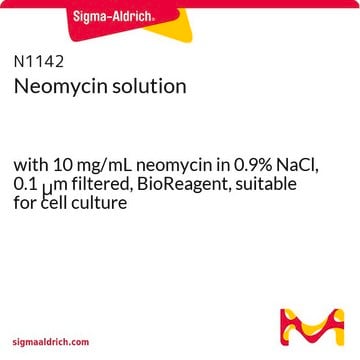If this product has an expiration or retest date, it will be shown on the Certificate of Analysis (COA, CofA). If there is no retest or expiration date listed on the product's COA, we do not have suitable stability data to determine a shelf life. For these products, the only date on the COA will be the release date; a retest, expiration, or use-by-date will not be displayed.
For all products, we recommend handling per defined conditions as printed in our product literature and website product descriptions. We recommend that products should be routinely inspected by customers to ensure they perform as expected.
For products without retest or expiration dates, our standard warranty of 1 year from the date of shipment is applicable.
For more information, please refer to the Product Dating Information document: https://www.sigmaaldrich.com/deepweb/assets/sigmaaldrich/marketing/global/documents/449/386/product-dating-information-mk.pdf
Wichtige Dokumente
SBR00022
Blasticidin S Fertiglösung
10 mg/mL (20 mM HEPES), 0.22 μm filtered
Größe auswählen
About This Item
Empfohlene Produkte
Qualitätsniveau
Sterilität
0.22 μm filtered
Assay
≥98% (HPLC)
Form
liquid
Konzentration
10 mg/mL (20 mM HEPES)
Farbe
colorless to faint yellow
Wirkungsspektrum von Antibiotika
fungi
Wirkungsweise
protein synthesis | interferes
Lagertemp.
−20°C
SMILES String
CN(CCC(CC(=O)NC1C=CC(OC1C(=O)O)N2C=CC(=NC2=O)N)N)C(=N)N.Cl
InChI
1S/C17H26N8O5.ClH/c1-24(16(20)21)6-4-9(18)8-12(26)22-10-2-3-13(30-14(10)15(27)28)25-7-5-11(19)23-17(25)29;/h2-3,5,7,9-10,13-14H,4,6,8,18H2,1H3,(H3,20,21)(H,22,26)(H,27,28)(H2,19,23,29);1H
InChIKey
YQXYQOXRCNEATG-UHFFFAOYSA-N
Verwandte Kategorien
Allgemeine Beschreibung
In der Forschung ist Blasticidin S ein wichtiges Hilfsmittel, insbesondere als Marker für Manipulationen von Stämmen. Seit einiger Zeit wird Blasticidin S auch als Selektionsmittel für Zellen verwendet, die Plasmide tragen, welche Blasticidinresistenz verleihen. Die Resistenz wird durch die Blasticidin-S-Deaminase-Gene (bsr von Bacillus cereus oder BSD von Aspergillus terreus) vermittelt. Diese Gene produzieren Enzyme, die die hydrolytische Desaminierung der Cytosineinheit in Blasticidin S katalysieren, was zur Bildung eines nicht toxischen Desaminohydroxy-Derivats führt. Dieser Resistenzmechanismus ist in verschiedenen Studien in der Zellbiologie und biochemischen Forschung, in denen genetische Veränderungen und Selektionen durchgeführt werden, von zentraler Bedeutung.
Anwendung
- zeigte in Studien fungizide Eigenschaften und wirkt vorbeugend gegen Weizenbrand.[1]
- wurde als Mittel zur Selektion transformierter Zellen verwendet, die die Resistenzgene bls, bsr oder bsd enthalten. Blasticidin S wurde zur Selektion von HEK293-T Zellen mit TLR-2 Konstrukten und HEK-D5 Zellen verwendet.[2][3]
- wurde zur Untersuchung der Proteinsynthese auf der Ebene der Bildung von Peptidbindungen verwendet.
Biochem./physiol. Wirkung
Antimikrobielles Spektrum: Aktiv gegen Mykobakterien, mehrere grampositive und gramnegative Bakterien
Leistungsmerkmale und Vorteile
- Für verschiedene Forschungsanwendungen geeignetes hochwertiges Antibiotikum,
- ideal für die Zellbiologie und biochemische Forschung
Sonstige Hinweise
Signalwort
Danger
H-Sätze
Gefahreneinstufungen
Acute Tox. 3 Oral
Lagerklassenschlüssel
6.1D - Non-combustible acute toxic Cat.3 / toxic hazardous materials or hazardous materials causing chronic effects
WGK
WGK 1
Flammpunkt (°F)
Not applicable
Flammpunkt (°C)
Not applicable
Hier finden Sie alle aktuellen Versionen:
Analysenzertifikate (COA)
Die passende Version wird nicht angezeigt?
Wenn Sie eine bestimmte Version benötigen, können Sie anhand der Lot- oder Chargennummer nach einem spezifischen Zertifikat suchen.
Besitzen Sie dieses Produkt bereits?
In der Dokumentenbibliothek finden Sie die Dokumentation zu den Produkten, die Sie kürzlich erworben haben.
Kunden haben sich ebenfalls angesehen
-
How can I determine the shelf life / expiration / retest date of this product?
1 answer-
Helpful?
-
-
How is shipping temperature determined? And how is it related to the product storage temperature?
1 answer-
Products may be shipped at a different temperature than the recommended long-term storage temperature. If the product quality is sensitive to short-term exposure to conditions other than the recommended long-term storage, it will be shipped on wet or dry-ice. If the product quality is NOT affected by short-term exposure to conditions other than the recommended long-term storage, it will be shipped at ambient temperature. As shipping routes are configured for minimum transit times, shipping at ambient temperature helps control shipping costs for our customers. For more information, please refer to the Storage and Transport Conditions document: https://www.sigmaaldrich.com/deepweb/assets/sigmaaldrich/marketing/global/documents/316/622/storage-transport-conditions-mk.pdf
Helpful?
-
-
Can you please advise the freeze/thaw cycle of this product?
1 answer-
This product is shipped at ambient temperature and may be stored at 4 °C for up to two weeks. For long term storage, -20 °C is recommended. The solution should be aliquoted prior to freezer storage. Avoid repeated freeze/thaw cycles.
Helpful?
-
Active Filters
Unser Team von Wissenschaftlern verfügt über Erfahrung in allen Forschungsbereichen einschließlich Life Science, Materialwissenschaften, chemischer Synthese, Chromatographie, Analytik und vielen mehr..
Setzen Sie sich mit dem technischen Dienst in Verbindung.









